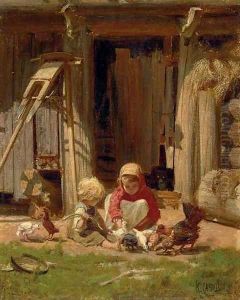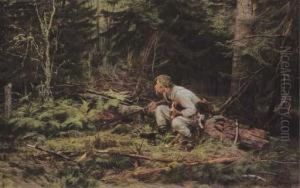Konstantin Apollonovich Savitskii Paintings
Konstantin Apollonovich Savitsky was a distinguished Russian painter, born on June 6, 1844, in Taganrog, at the southeastern tip of the Azov Sea in Russia. His early life was shaped by the cultural milieu of the Russian Empire, and from a young age, he exhibited a keen interest in the arts. Savitsky's education in art began at the Moscow School of Painting, Sculpture and Architecture, and he later honed his skills at the prestigious Imperial Academy of Arts in Saint Petersburg, where he studied under the tutelage of notable artists such as Pavel Chistyakov. His academic prowess earned him several awards and scholarships, which allowed him to travel and study art across Europe, further enriching his style and technique.
Savitsky's work is often categorized within the Realist movement, a testament to his ability to capture the nuanced realities of life, nature, and the human condition with a remarkable sense of detail and emotional depth. He was particularly known for his genre scenes, historical paintings, and his ability to portray the lives of the Russian peasantry with dignity and compassion. One of his most celebrated works, 'Repairing the Railway', exemplifies his skill in depicting the Industrial Revolution's impact on Russian society and the working class.
An active member of the Peredvizhniki (Wanderers), a cooperative of Russian realist artists who sought to break away from the traditional academy restrictions to engage directly with the public, Savitsky played a significant role in the movement's efforts to depict social injustices and promote public discourse through art. His involvement with the Peredvizhniki not only influenced his artistic direction but also solidified his reputation as a socially conscious artist committed to exploring the complexities of Russian life.
Throughout his career, Savitsky's contributions to Russian art were recognized with numerous awards and honors. His works were widely exhibited in Russia and abroad, gaining him international acclaim. Konstantin Apollonovich Savitsky's legacy is preserved in his impactful body of work, which continues to be celebrated in museums and galleries around the world for its artistic merit and historical significance. He passed away on August 13, 1905, in Penza, leaving behind a rich legacy that continues to inspire and influence the art world.






